There is a strong case for having communicators as a vital part of your snowmobile kit and the Cardo PackTalk Bold review only reinforces this opinion further. As stated before, safety, security and convenience are the main reasons for two-way radios to be in the snowmobile arsenal.
That said, what would be the ingredients for the Holy Grail of communications on the trail? To this writer the parameters would be reasonable cost, very good range, all-day battery life, VOX, and most important, crystal clear communication. Nothing beats a conversation while riding on the trail that rivals two people chatting away on a couch right next to each other.
Cardo PackTalk Bold Communication for Snowmobilers
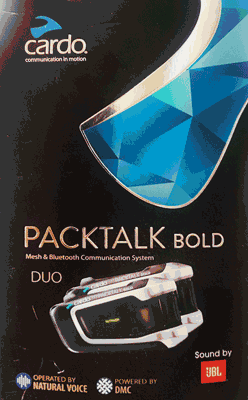
Entering the ring is the latest challenger in that Holy Grail quest – Cardo Systems PackTalk Bold. There are a number of players in the sporting communication field to pick from but the motorcycle community seems to be the hot bed of activity in this space.
One particular brand kept coming up in the reviews, and that was Cardo PackTalk. When I reached out to the factory in Plano, Texas they said that the PackTalk would meet all of my needs. It’s water resistant, has good cold weather battery life, VOX, is easy to install, and most importantly, crystal clear communications.
The Back Country Access (BCA) radios, previously reviewed, have excellent range, are well built, and best suited for the niche they were intended – group riding in mountainous terrain. In that element they are not only essential but, in some places, mandatory, and they shine spectacularly. The one drawback was the lack of voice activated technology (VOX).
What’s in the PackTalk Bold Duo Box
Now that the intros are done let’s take a not so deep dive into the box as it comes from the factory. I purchased the PackTalk Bold Duo Edition, for two riders. The box contains two radios, JBL ear speakers that go inside the helmet, mounting plates for the radios, double sided tape for install.
There is a supplied USB to mini USB cord but no charging brick, along with copious directions written in nine languages, including English-Tres Bien!
PackTalk and BRP Oxygen Helmet
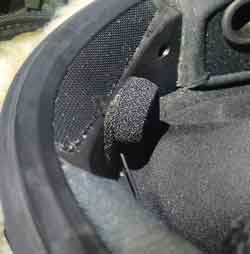
First, the microphone was Velcroed inside the front area of my BRP Oxygen helmet.
I was excited to see that the audio giant JBL and PackTalk have joined forces. Installation of the helmet speakers is a somewhat tedious affair as you have to get the wiring underneath the padding on both left and right sides and attach them using Velcro.
Sticking the base plate to the helmet exterior is an easy affair using the supplied double-sided tape. The main unit clips right in and out of this baseplate easily, so no worries there.
Instructions: Cardo’s YouTube Channel is Best
Regarding the written instructions, I suggest tossing those in the trash and instead watch the great video tutorials on Cardo’s YouTube channel for set-up and operations, as we did for this Cardo PackTalk Bold review. There’s too much to repeat here, directions-wise, but suffice it to say that there are three buttons on the face for Media, Phone and Intercom.
Pairing PackTalk Bluetooth Units
Basically, once on, the color green flashes to indicate the unit is indeed powered up. Do the same with the second unit. Follow the video to pair, and voila, instant communication. You only have to pair once, they automatically connect from then on. Since the unit is Bluetooth you can also pair up to two other devices, such as a phone and GPS. We found the phone pairing to be quite handy when we had lost long range radio communication.
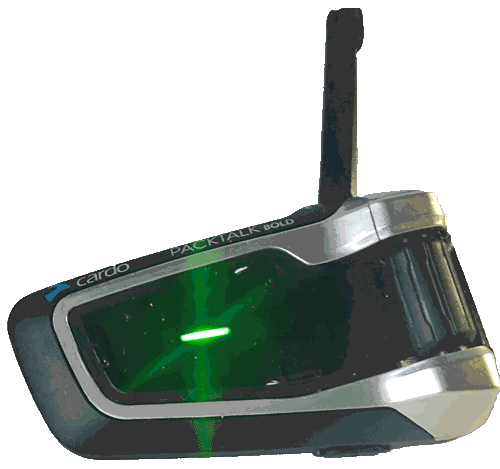
Okay, they are on and paired, so now what? Just speak in to the microphone and your riding partner will hear what you say through the helmet speakers. Matter of fact, you can pair up to 15 riders so everyone can speak within the group, or have a private transmission if so desired.
By means of proprietary technology, called Dynamic Mesh Communication, riders can go in and out of range at any time and the unit will re-pair for seamless communications. There are all sorts of voice commands you can use to make calls, play music, or even ask for battery voltage remaining. Sweet!
PackTalk Bold Test on Snowmobile
All that said, how does the system work in real world conditions? On our last long-distance saddlebag tour of New Brunswick, we had a good chance to try these puppies out. Was this the Holy Grail we’ve been searching for?
Our first day using them was good, perfectly uneventful. Sound quality, range and battery life were all good. At the end of that day, which by the way was not cold at all, we were feeling really positive about this system. We were once again on speaking terms! Ha-Ha.
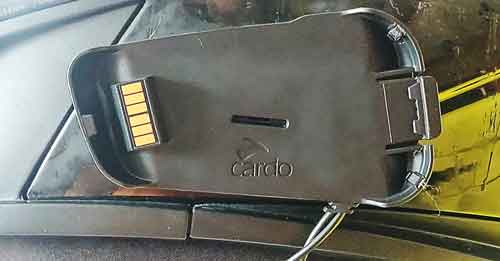
However, we did notice that wind noise still plagued us. The stock JBL speakers delivered on clear sound, at its best when there was zero engine or wind noise. Don’t get me wrong, the clarity was considered good to very good while riding but still was best at a stop with engine off.
Is there a way around this? Lo and behold, my friend purchased a set of Bose QuietComfort 20 noise canceling in-ear headphones before our trip. At first, I was skeptical of being able to mate this system to the Cardo system but it turned out to be a simple affair with absolutely zero fuss.
Bose QuietComfort 20 Noise Cancelling Headphones
The next day of riding would prove to be very interesting, for sure. We hooked-up the Bose QC20 to the Cardo, made a radio check, and off we went. To my great surprise and amazement, the Bose QC system immediately cut over 90% of wind noise and the majority of engine noise! Yikes! Was I still in bed dreaming of utopian riding conditions? Nope, it truly was the real deal.
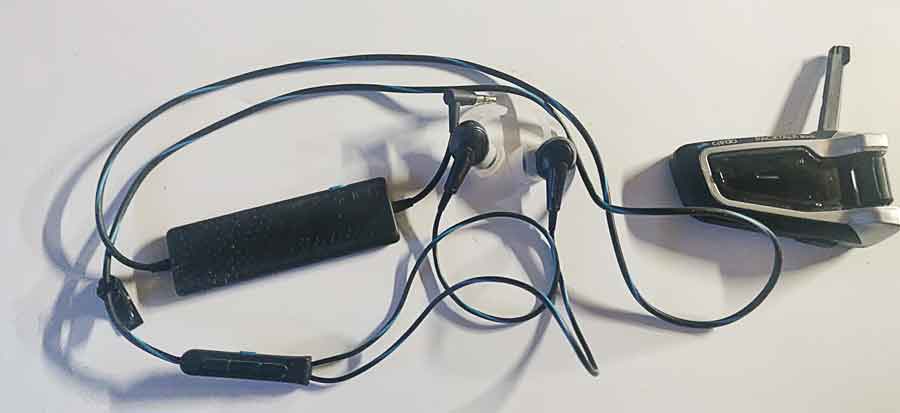
When starting off, the snowmobile engine would rev up to a certain decibel level at which time the Bose system kicked in and nipped the noise right in the bud. Attenuated is the technical term. Wow, was I impressed. Communications under riding conditions were in fact crystal clear, almost as if we were talking while riding in a side by side!
The rest of the day went by with an adjustment to the ear cups and cable positioning but underneath those helmets we had huge grins on our faces. In addition, my ears were not ringing at the end of the day from wind noise. That’s a huge benefit that will pay dividends as you get older, for sure, and certainly made me feel less tired at the end of the day.
Bose Upgrade for Cardo PackTalk
So, where are we now? We’ve got a Cardo PackTalk system that works great but is taken to the next level of performance with the addition of noise canceling earbuds by Bose. Let’s take a brief look at the Bose QuietComfort 20.
They retail for about $250 per unit but deals can be had on various sites like eBay and Amazon. I chose to purchase the two-year extended service plan as these will get used a lot and are often in hostile outdoor conditions.
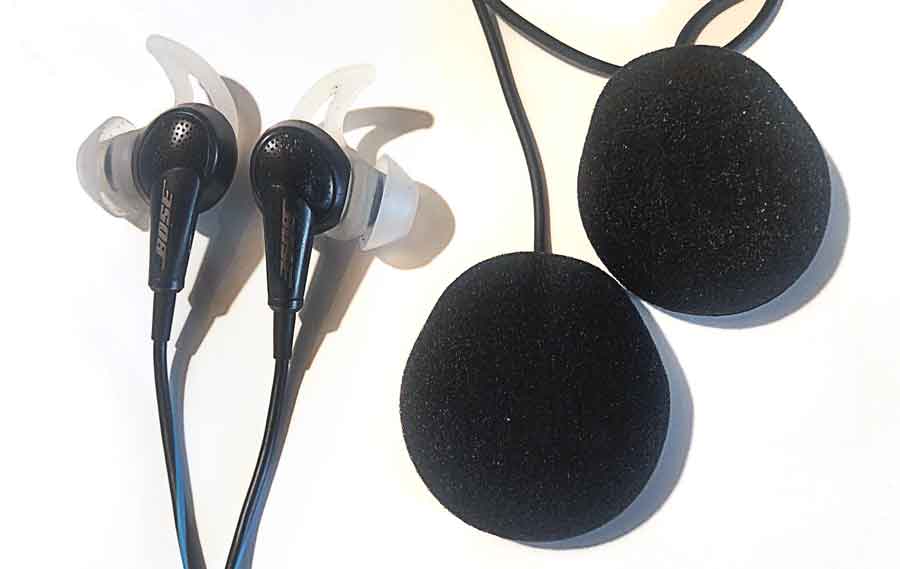
They are wired earbuds with silicone cups and are almost all-day comfortable. The ear cups in the BRP Oxygen helmet were no longer needed. A good thing, as they caused a lot of pain when combined with the Bose earphones. Without the ear cups I hardly knew the earbuds were there.
We had to purchase an extended cable so that the wafer-thin battery pack could be stored inside a jacket pocket. The connection was a simple mini phone jack to a mini plug on the Cardo system. A mini USB cable is used to recharge the Bose system nightly. Turn the unit on by sliding a button and away you go. The JBL ear speakers were removed from the helmet.
Bose QuietComfort As Hearing Protection
I’ve found that the Bose earbuds can be used for many other tasks as well. They are not a specific use device at all. Because of the noise canceling effectiveness I use them for mowing the lawn, working with a chain saw, table saw, and any other device that makes a racket.
They perform as advertised and save my precious hearing as well. The QuietComfort buds don’t block all sound, just the stuff that’s going to hurt your hearing. People talking, running water, sleds coming up at slow speeds when you’re at a stop, they are all still there for safety reasons.
High Cost of Having Fun
Hey it’s official – it costs lots of money to have fun! Due to the high cost of this specialized equipment, a single PackTalk Bold is $250, and the Bose QuietComfort 20 about $250 per unit, it might be best to get the Cardo system one year and the Bose the following year.
If you’re in the market for two radios and want to save some decent cash, consider the PackTalk Bold Duo Edition, about $450, which is what I did.
Conclusion: PackTalk Bold and Bose QuietComfort 20
So, is the PackTalk Bold by itself or connected with the Bose QuietComfort 20 the Holy Grail of trail communications? Not quite…. but very close, and here’s why: Ideally all of these technologies should be mated in one compact, neat package.
My wish list includes noise cancellation, Bluetooth enabled, voice commands, completely wireless, crystal clear voice, consistent one-mile range over hills and on cloudy days, and GPS enabled, so if one rider is lost you have a “ping” feature to triangulate their location.
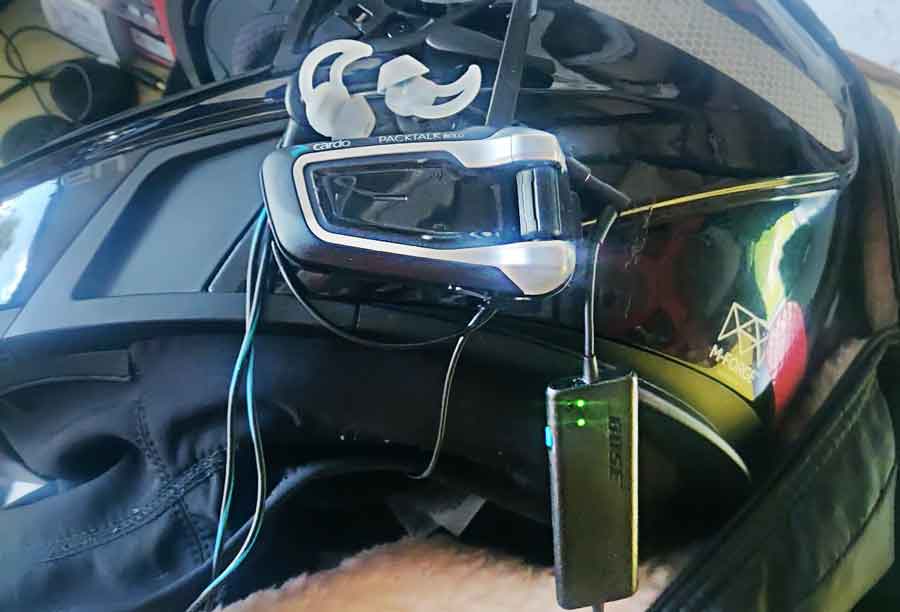
When paired with a voice enabled GPS device, the PackTalk Bold has the capability to give turn by turn navigation through the headset. That is huge. How many times have you come to an intersection with no signs and unsure of which way to go? Been there, done that, many times.
We found radio range averaged eight-tenths of a mile. In perfect line of sight, in good weather, maybe a mile. Battery life couldn’t be thoroughly tested in sub-arctic conditions, as it was mild for the duration of our trip.
No doubt some of you folks are skeptical if these communicators are actually worth the money. I get that, but take it from someone who’s had many years of near misses from trail hazards. These are really the way to go.
When you are so far out in the bush that you begin to feel isolated from humanity, having a friendly voice can make you feel part of the team with a specific destination.
Cardo PackTalk Bold Review HITS:
- Best product tested, to date
- Clear communications with noise canceling earbuds
- Voice activation instantaneous with no delay
- Small package, easy to install
- YouTube tutorials are useful
- Battery life very good
- Bluetooth phone calls
- Pair with GPS unit
- Line of sight range
- Voice commands are the bomb
- FM radio and music via phone (not tested)
MISSES:
- Expensive $$$
- Making calls can be a hit or miss proposition
- Needs additional noise canceling system to make best of breed
- Sometimes units unpair themselves and then re-pair
- Abysmal written instructions
- YouTube a must for set up and installation
- Range could be better
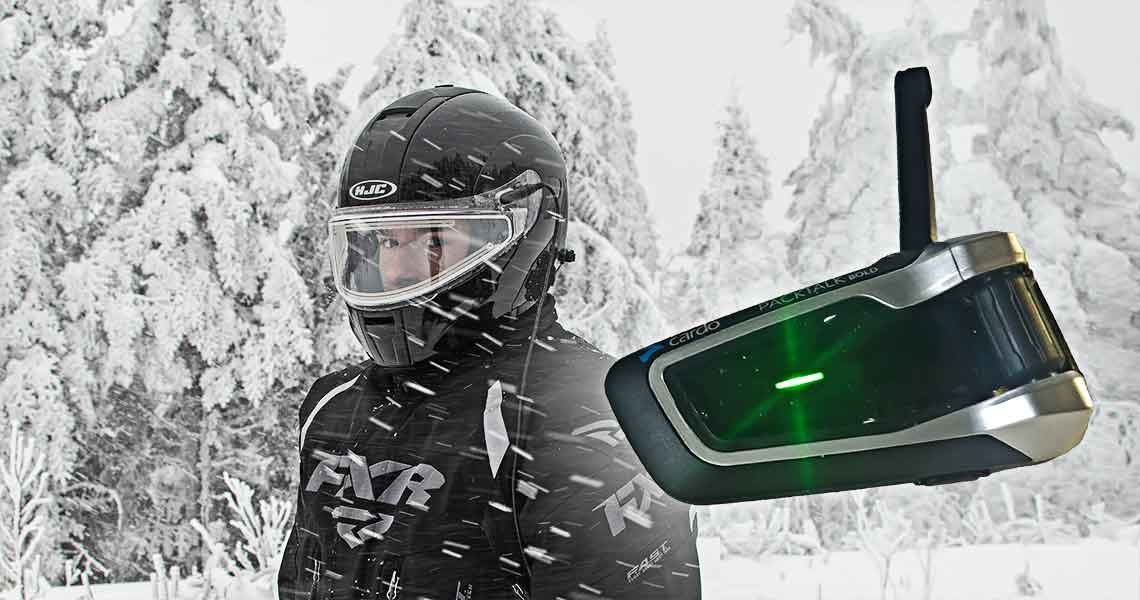
You must be logged in to post a comment.